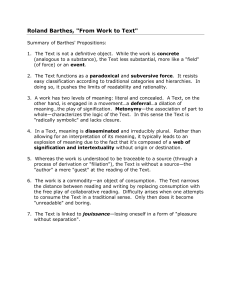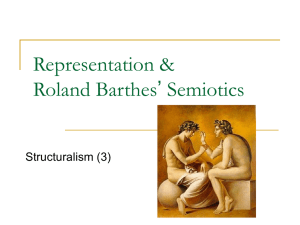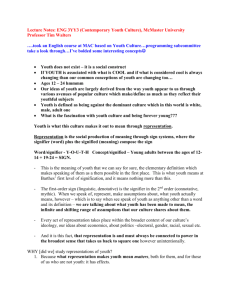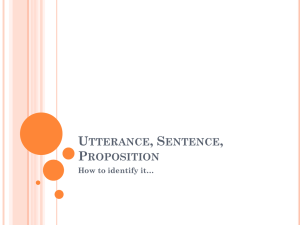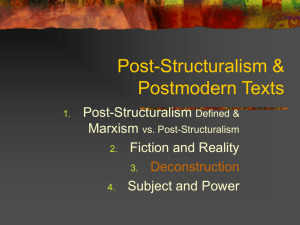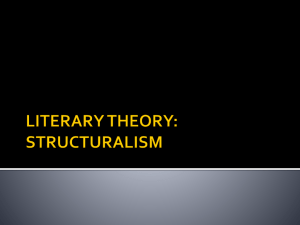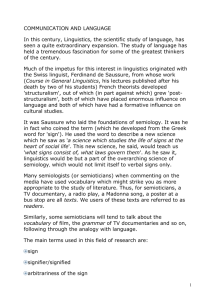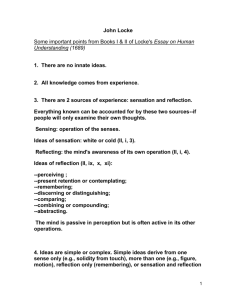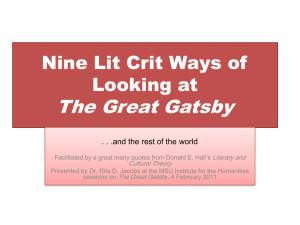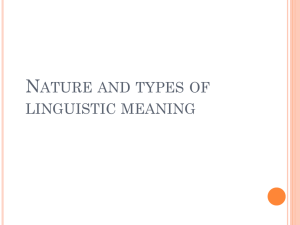Sign
advertisement
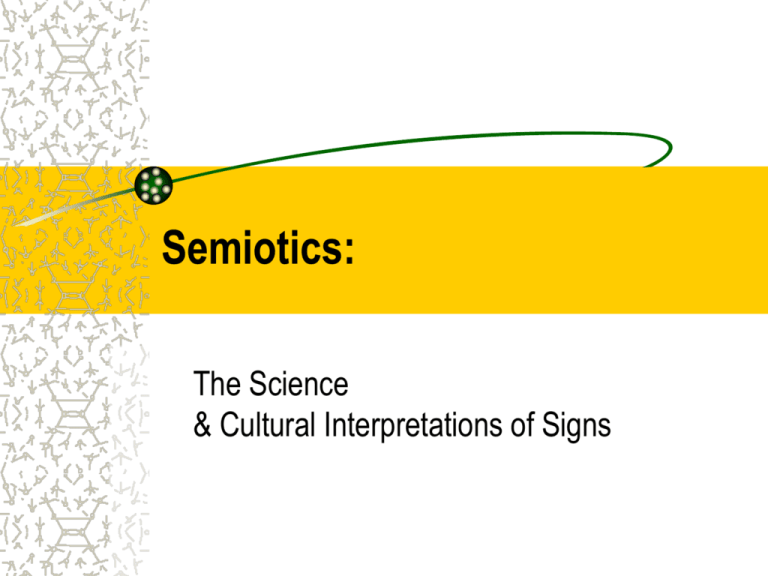
Semiotics: The Science & Cultural Interpretations of Signs Binary Oppositions in Structuralism langue, parole; signifer – signified; Diachronic – Synchronic; Axis of combination - Axis of selection Metaphor - metonymy Paradigmatic/Selection: Language/Literature as an enclosed system with two Axes Syntagmatic/Combination (narrative structure: roles + actions); metonymy Thematic structure: Motifs, mythemes, metaphors, etc. Roman Jakobson’s studies of poetry and aphasia metaphor – substitution of one with something similar –poetry – Romanticism/Symbolism metonymy – replacement of one with something close by -- novel --Realism Similarity disorder – inability to deal with “associative” relationships in language. Contiguity disorder – inability to organize words into higher units (e.g. sentence). “The poetic function projects the principle of equivalence from the axis of selection into the axis of combination.” Jakobson Jakobson’s six factors in speech and their interactions Context/Soceity, History Message Addresser Author Contact Code/ Text Addressee Reader * Usu. in one speech event, one factor will dominate over the others. For instance, the “emotive” intent of the address dominant his/her use of code, the context as well as the contact. C. S. Peirce: Three Kinds of Signs Based on relations between signifier and signified Icon – resemblance (This refers to one’s home thru’ resemblance, to websites’ homepage by convention. ) Index– factual/causal connection Symbol -- rule of convention or habitual association = love The connection is the most arbitrary. Examples: Iconic functions in poetry The use of poetic form (iconic signs in poetry) to refer back to itself. Symbolic signs in poetry can be easily found; how about indexical signs? Or maybe we can say that the indexical signs—such as the wreckage in “Ozymandias” take on symbolic meanings in the poem. ) Example 1: e. e. cummings’ breaking the iconic sign of sonnet "next to of course god america i love you land of the pilgrims' and so forth oh say can you see by the dawn's early my country 'tis of centuries come and go and are no more what of it we should worry in every language even deafanddumb thy sons acclaim your glorious name by gorry by jingo by gee by gosh by gum why talk of beauty what could be more beautiful than these heroic happy dead who rushed like lions to the roaring slaughter they did not stop to think they died instead then shall the voice of liberty be mute?" e. e. cummings’ breaking the iconic sign of sonnet He spoke. And drank rapidly a glass of water -- e. e. cummings; 1926 This Is Just To Say I have eaten the plums that were in the icebox and which you were probably saving for breakfast Example2: the “forming” of trivial matter In daily life. Forgive me they were delicious so sweet and so cold. William Carlos Williams (1883-1963) Roland Barthes: Production of Sign and Myth All social practices as sign-systems and thus are open to cultural interpretation (or demystification). e.g. the “langue” of clothes and food system: a. blouse, shirt, T-shirt ; b. skirt, trousers sentence: an ensemble of blouse + skirt + high heeled shoes X snickers blouse + jeans + snickers Xnot for concert Fashion and Myth “The clothes for this summer is made predominantly of silk.” (prescriptive rather than descriptive) “It’s nice to wear while walking on a dock with your lover.” Different levels of signification: primary signification & secondary signification a signifier + signified = sign (full)--denotation primary signification: Secondary signification Sign (empty)/ Form + content = sign --connotation Different levels of signification: example signifier (Rose) + signified (Flower)= sign (full)--denotation (empty) primary signification: Form( Secondary signification + ) content (Love)= sign --connotation “Myth Today” a second-order semiological system regression from meaning to form, from the linguistic sign to the mythical signifier. ...the form does not suppress the meaning, it only impoverishes it, it puts it at a distance... elements of an ad. 1. the slogan (or copy) 2. the visual image--with the slogan, it implies a story 3. supplementary --color, design == where the product, the words are placed – – – – colour, size and position, texture celebrity endorsement Ads: Example 1 Ads: Example 2 Ads: Example 3 Ads: Example 4 Ads’ languages -- from Ways of Seeing The romantic use of nature (leaves, trees, water) to create a place where innocence can be found. The posed taken up to denote stereotypes of women: serene mothers (madonna), free wheeling secretary (actress, king's mistress), perfect hostess (spectator-owner's wife), sexobject (Venus, nymph surprised), etc. The special sexual emphasis given to women's legs. Ads’ languages -- from Ways of Seeing (2) The materials particularly used to indicate luxury: engraved metal, furs, polished leather, etc. The physical stance of men conveying wealth and virility. The equation of drinking and success. The man as knight (horseman) become motorist. Key words for Structualist and Semiotic approaches: I. Following language as a model II. Disclosing the deep/basic structure of a text, which is a (combination or selection) system of meaning composed of basic elements such as: Questions: Reductive? Disregarding meaning, textual complexities, or the author’s intention? De-centering, dehumanizing? Do we really think in terms of binaries? How is our social existence modeled after language as a system of relations? – – – – From work to text (textuality); From identity to system of relations; From myth to ideology; “Myth -- the complex system of images and beliefs which a society constructs in order to sustain and authenticate its sense of being.” – From structuralism/semiotics to marxism -- binaries, or semiotic rectangles, -- roles/actant and functions, or narrateme, -- story and discourse, -- narrator- narratee, -- metaphor and metonymy, -- grammatical parts of speech, or lexemes, -- signs or signification on different levels (signifier and signified).
